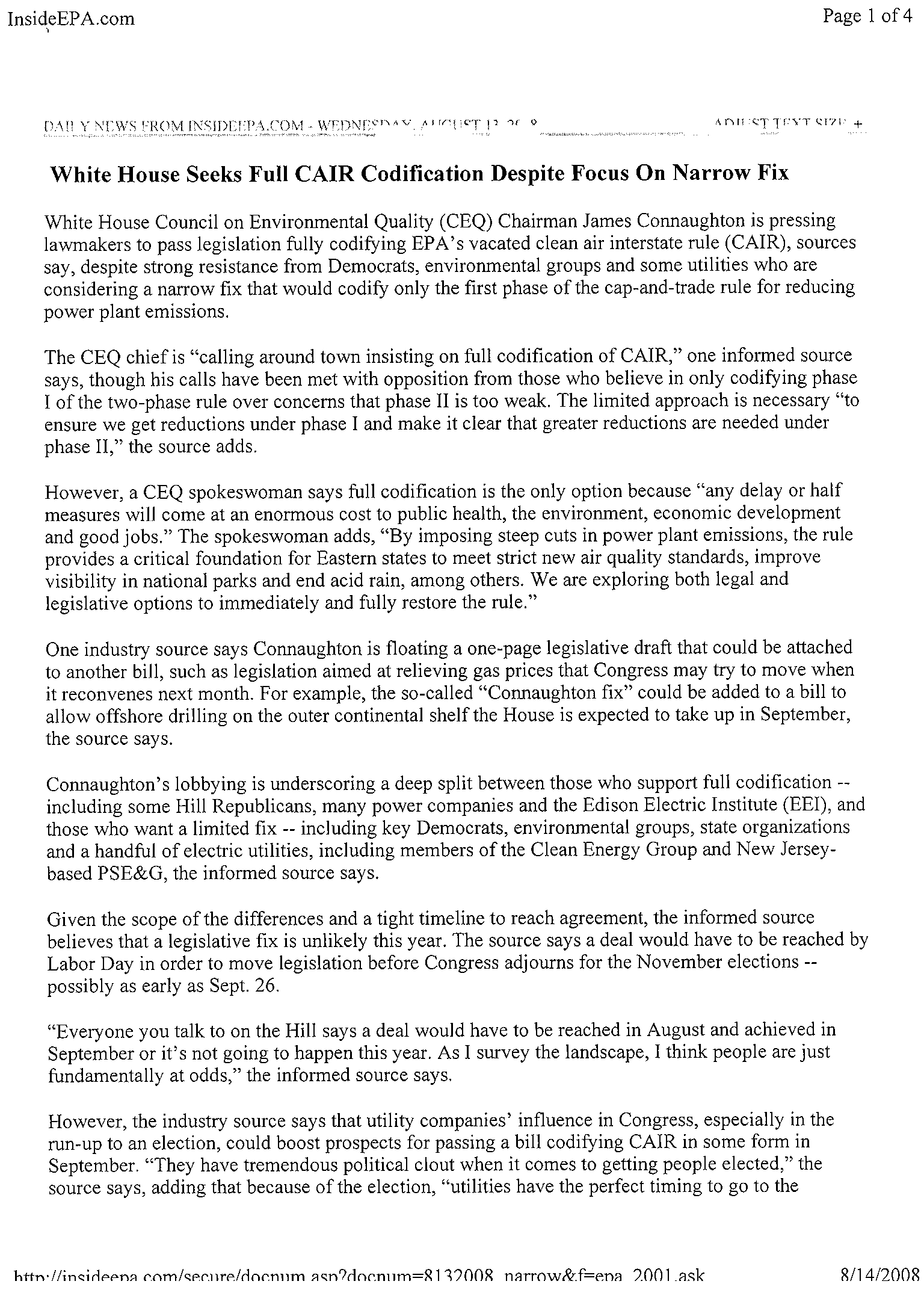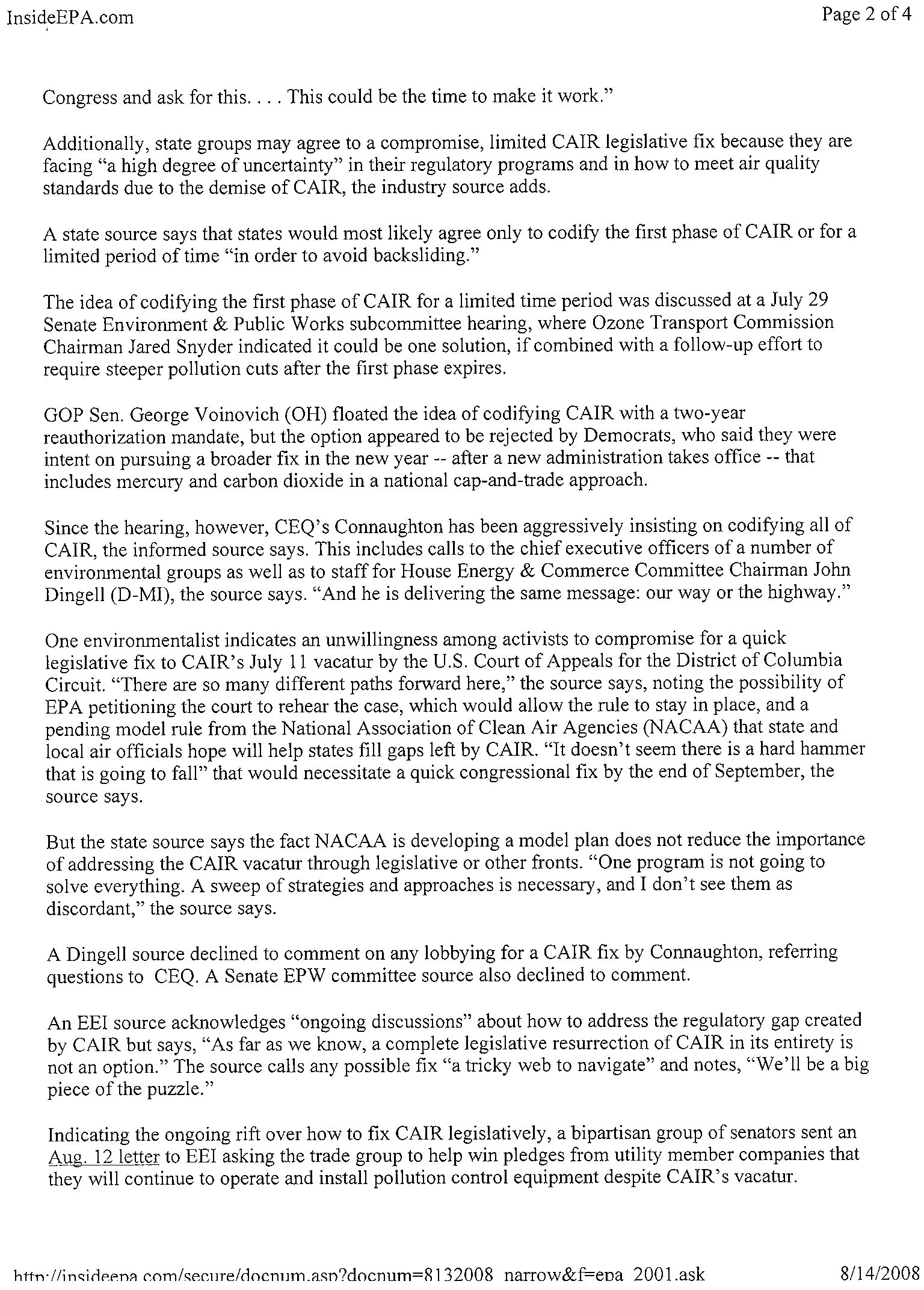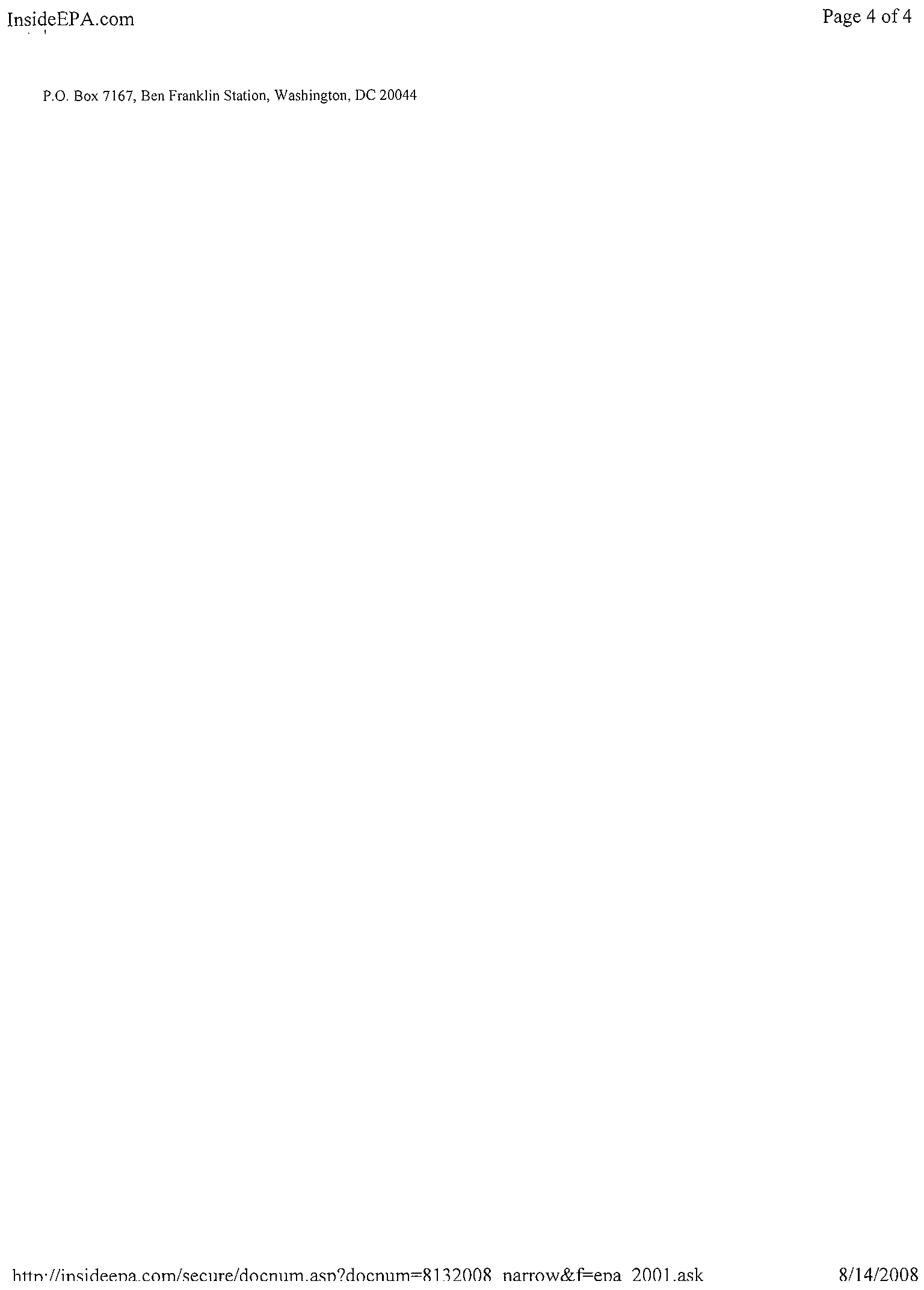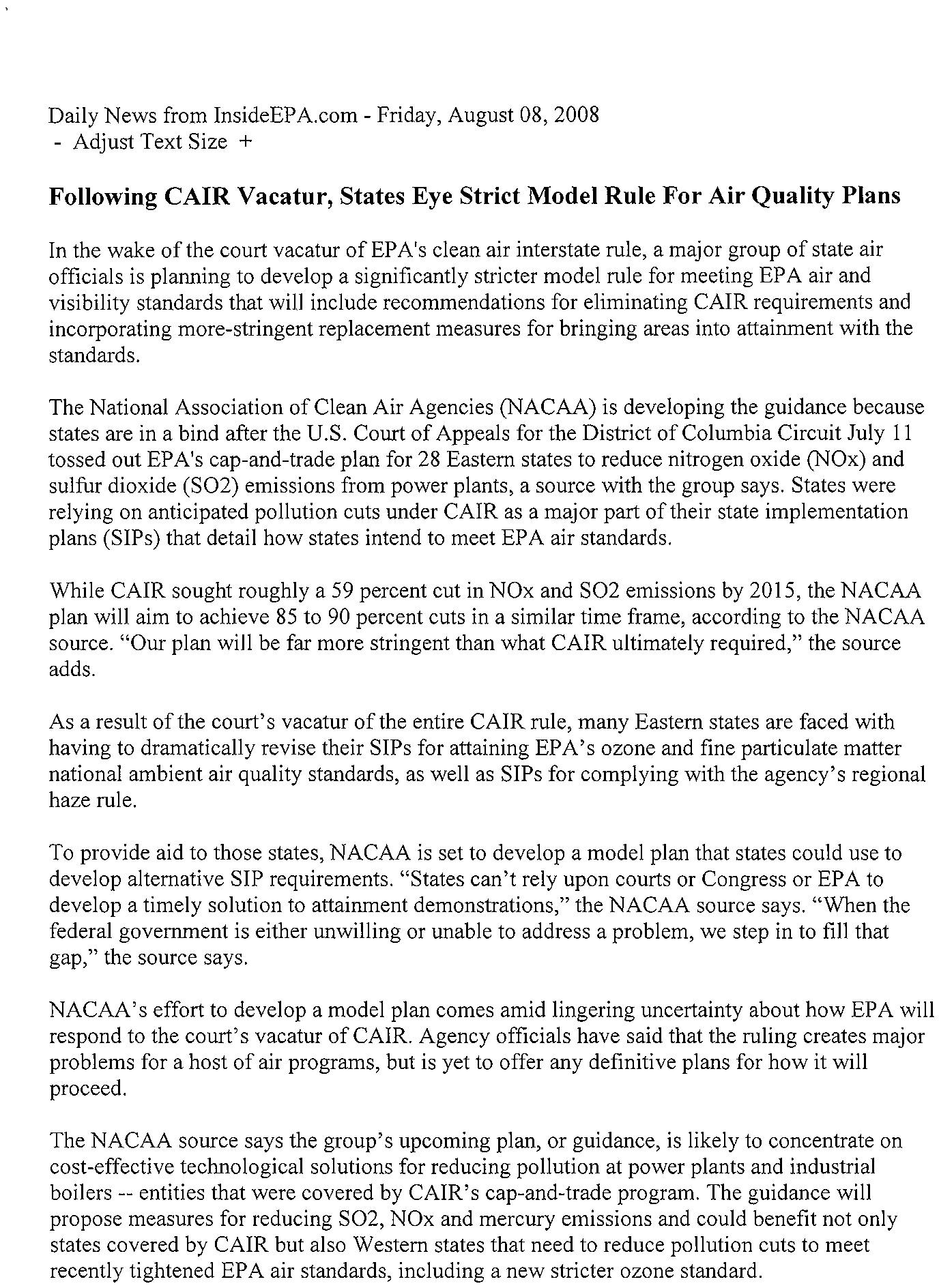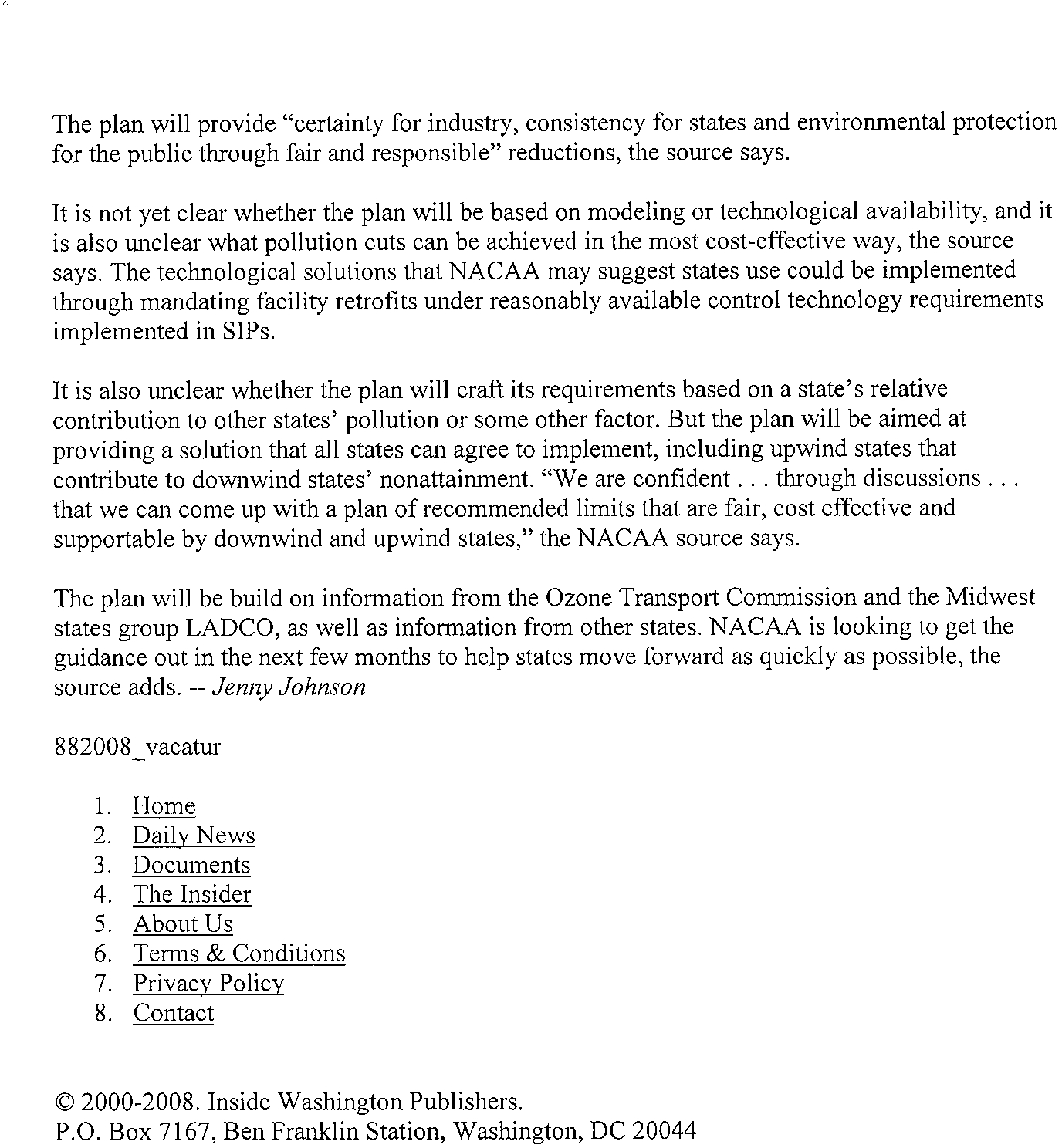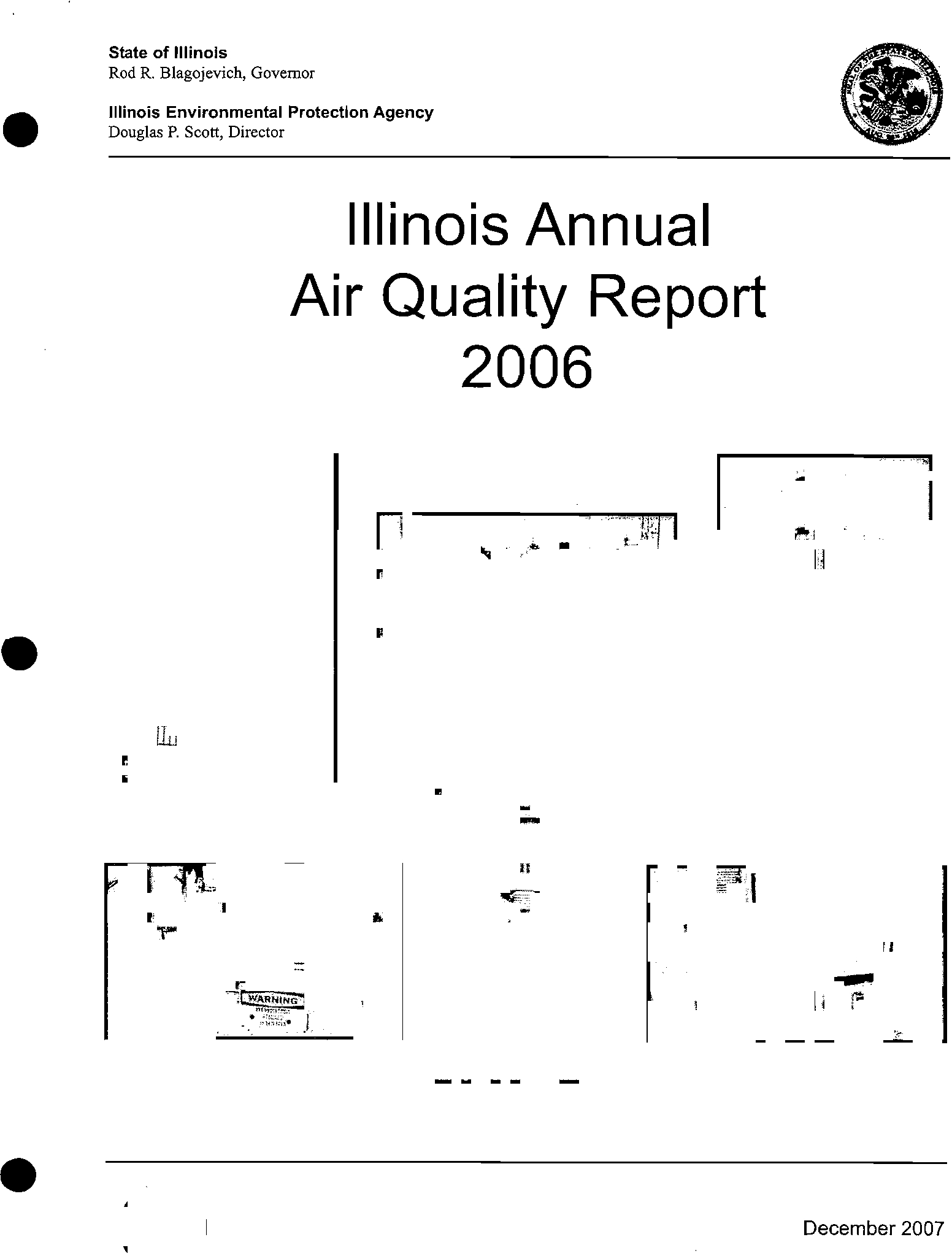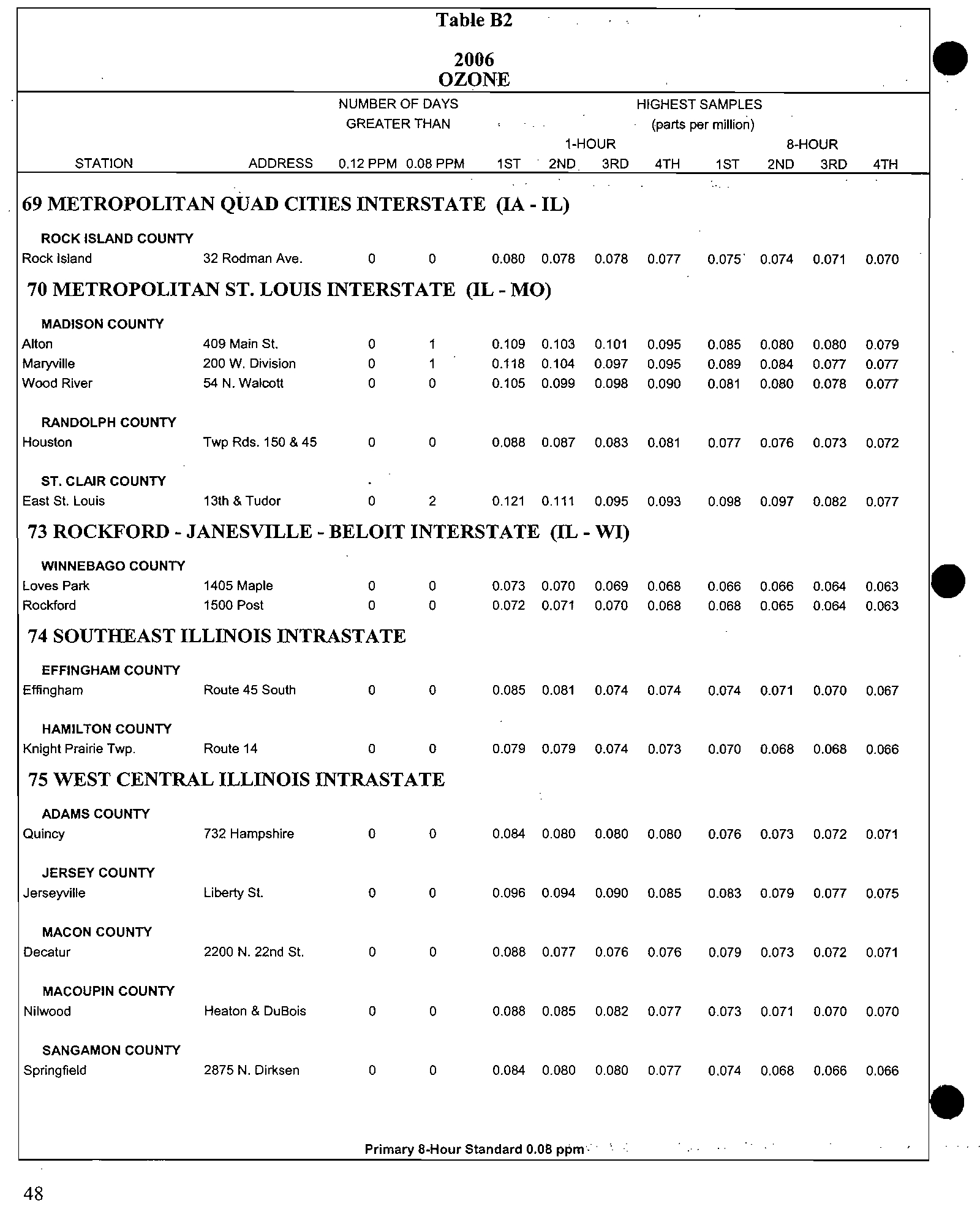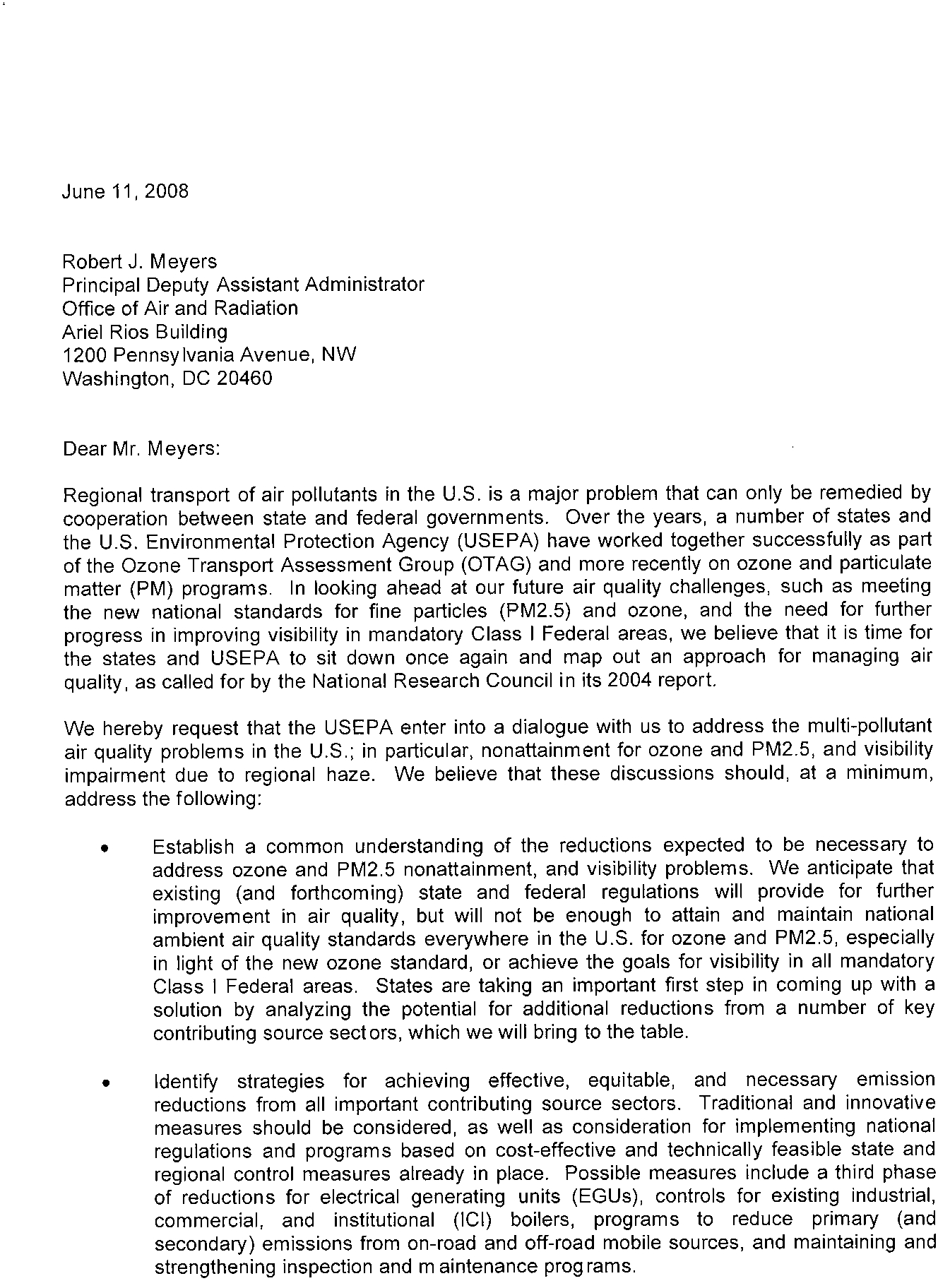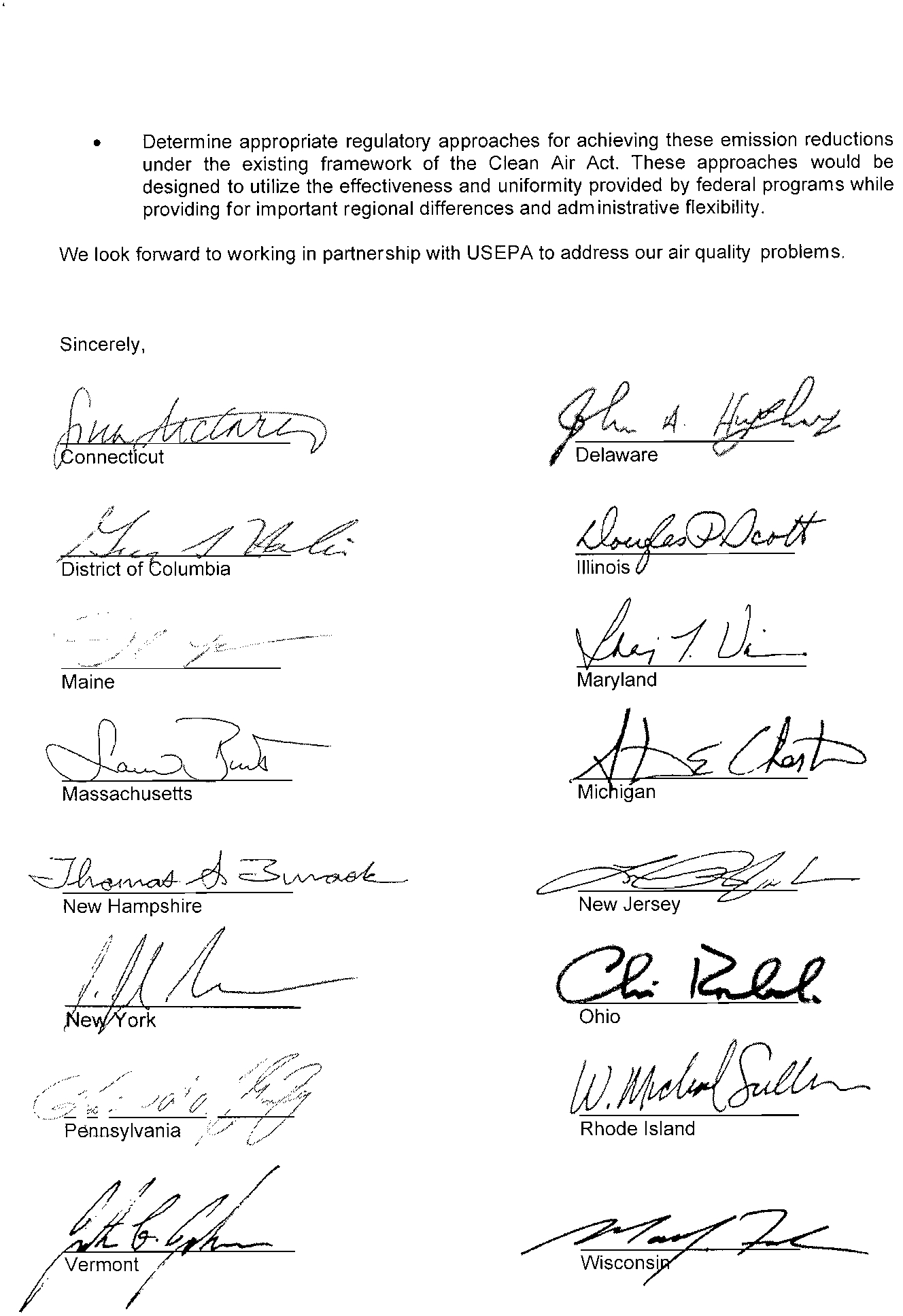Dawn
Reeves
and
Jenny
Johnson,
"White
House
Seeks
Full
CAIR
Codification
Despite
Focus
on
Narrow
Fix,"
InsideEPA
(August
13,
2008),
<
www.insideepa.com/secure/docnum.asp?docnum=8132008
narrow&f=
epa
2001.ask
>.
Dawn
Reeves
and
Jenny
Johnson,
"White
House
Seeks
Full
CAIR
Codification
Despite
Focus
on
Narrow
Fix,"
InsideEPA
(August
13,
2008),
<
www.insideepa.com/secure/docnum.asp?docnum=8132008
narrow&f=
epa
2001.ask
>.
Electronic Filing - Received, Clerk's Office, October 1, 2008
* * * * * PCB 2009-021 * * * * *
say,
despite
strong
resistance
from
Democrats,
environmental
groups
and
some
utilities
who
are
considering
a
narrow
fix
that
would
codify
only
the
first
phase
of
the
cap-and-trade
rule
for
reducing
power
plant
emissions.
The
CEQ
chief
is
"calling
around
town
insisting
on
full
codification
of
CAIR,"
one
informed
source
says,
though
his
calls
have
been
met
with
opposition
from
those
who
believe
in
only
codifying
phase
I
of
the
two-phase
rule
over
concerns
that
phase
II
is
too
weak.
The
limited
approach
is
necessary
"to
ensure
we
get
reductions
under
phase
I
and
make
it
clear
that
greater
reductions
are
needed
under
phase
II,"
the
source
adds.
However,
a
CEQ
spokeswoman
says
full
codification
is
the
only
option
because
"any
delay
or
half
measures
will
come
at
an
enormous
cost
to
public
health,
the
environment,
economic
development
and
good
jobs."
The
spokeswoman
adds,
"By
imposing
steep
cuts
in
power
plant
emissions,
the
rule
provides
a
critical
foundation
for
Eastern
states
to
meet
strict
new
air
quality
standards,
improve
visibility
in
national
parks
and
end
acid
rain,
among
others.
We
are
exploring
both
legal
and
legislative
options
to
immediately
and
fully
restore
the
rule."
One
industry
source
says
Connaughton
is
floating
a
one-page
legislative
draft
that
could
be
attached
to
another
bill,
such
as
legislation
aimed
at
relieving
gas
prices
that
Congress
may
try
to
move
when
it
reconvenes
next
month.
For
example,
the
so-called
"Connaughton
fix"
could
be
added
to
a
bill
to
allow
offshore
drilling
on
the
outer
continental
shelfthe
House
is
expected
to
take
up
in
September,
the
source
says.
Connaughton's
lobbying
is
underscoring
a
deep
split
between
those
who
support
full
codification
--
including
some
Hill
Republicans,
many
power
companies
and
the
Edison
Electric
Institute
(EEl),
and
those
who
want
a
limited
fix
--
including
key
Democrats,
environmental
groups,
state
organizations
and
a
handful
of
electric
utilities,
including
members
of
the
Clean
Energy
Group
and
New
Jersey-
based
PSE&G,
the
informedsource
says.
Given
the
scope
of
the
differences
and
a
tight
timeline
to
reach
agreement,
the
informed
source
believes
that
a
legislative
fix
is
unlikely
this
year.
The
source
says
a
deal
would
have
to
be
reached
by
Labor
Day
in
order
to
move
legislation
before
Congress
adjourns
for
the
November
elections
--
possibly
as
early
as
Sept.
26.
"Everyone
you
talk
to
on
the
Hill
says
a
deal
would
have
to
be
reached
in
August
andachieved
in
September
or
it's
not
going
to
happen
this
year.
As
I
survey
the
landscape,
I
think
people
are
just
fundamentally
at
odds,"
the
informed
source
says.
However,
the
industry
source
says
that
utility
companies'
influence
in
Congress,
especially
in
the
run-up
to
an
election,
could
boost
prospects
for
passing
a
bill
codifying
CAIR
in
some
form
in
September.
"They
have
tremendous
political
clout
when
it
comes
to
getting
people
elected,"
the
source
says,
adding
that
because
of
the
election,
"utilities
have
the
perfect
timing
to
go
to
the
httn./lin<::inppn::l
rnm/<::p:('.llrp./rlnr.nnm
~<::.n?rlo('.nllm=R
11?OOR
n~rr()w&.f=en;::t
?OO
1
.:::t<::k
RI14/200R
say,
despite
strong
resistance
from
Democrats,
environmental
groups
and
some
utilities
who
are
considering
a
narrow
fix
that
would
codify
only
the
first
phase
of
the
cap-and-trade
rule
for
reducing
power
plant
emissions.
The
CEQ
chief
is
"calling
around
town
insisting
on
full
codification
of
CAIR,"
one
informed
source
says,
though
his
calls
have
been
met
with
opposition
from
those
who
believe
in
only
codifying
phase
I
of
the
two-phase
rule
over
concerns
that
phase
II
is
too
weak.
The
limited
approach
is
necessary
"to
ensure
we
get
reductions
under
phase
I
and
make
it
clear
that
greater
reductions
are
needed
under
phase
II,"
the
source
adds.
However,
a
CEQ
spokeswoman
says
full
codification
is
the
only
option
because
"any
delay
or
half
measures
will
come
at
an
enormous
cost
to
public
health,
the
environment,
economic
development
and
good
jobs."
The
spokeswoman
adds,
"By
imposing
steep
cuts
in
power
plant
emissions,
the
rule
provides
a
critical
foundation
for
Eastern
states
to
meet
strict
new
air
quality
standards,
improve
visibility
in
national
parks
and
end
acid
rain,
among
others.
We
are
exploring
both
legal
and
legislative
options
to
immediately
and
fully
restore
the
rule."
One
industry
source
says
Connaughton
is
floating
a
one-page
legislative
draft
that
could
be
attached
to
another
bill,
such
as
legislation
aimed
at
relieving
gas
prices
that
Congress
may
try
to
move
when
it
reconvenes
next
month.
For
example,
the
so-called
"Connaughton
fix"
could
be
added
to
a
bill
to
allow
offshore
drilling
on
the
outer
continental
shelfthe
House
is
expected
to
take
up
in
September,
the
source
says.
Connaughton's
lobbying
is
underscoring
a
deep
split
between
those
who
support
full
codification
--
including
some
Hill
Republicans,
many
power
companies
and
the
Edison
Electric
Institute
(EEl),
and
those
who
want
a
limited
fix
--
including
key
Democrats,
environmental
groups,
state
organizations
and
a
handful
of
electric
utilities,
including
members
of
the
Clean
Energy
Group
and
New
Jersey-
based
PSE&G,
the
informedsource
says.
Given
the
scope
of
the
differences
and
a
tight
timeline
to
reach
agreement,
the
informed
source
believes
that
a
legislative
fix
is
unlikely
this
year.
The
source
says
a
deal
would
have
to
be
reached
by
Labor
Day
in
order
to
move
legislation
before
Congress
adjourns
for
the
November
elections
--
possibly
as
early
as
Sept.
26.
"Everyone
you
talk
to
on
the
Hill
says
a
deal
would
have
to
be
reached
in
August
andachieved
in
September
or
it's
not
going
to
happen
this
year.
As
I
survey
the
landscape,
I
think
people
are
just
fundamentally
at
odds,"
the
informed
source
says.
However,
the
industry
source
says
that
utility
companies'
influence
in
Congress,
especially
in
the
run-up
to
an
election,
could
boost
prospects
for
passing
a
bill
codifying
CAIR
in
some
form
in
September.
"They
have
tremendous
political
clout
when
it
comes
to
getting
people
elected,"
the
source
says,
adding
that
because
of
the
election,
"utilities
have
the
perfect
timing
to
go
to
the
httn./lin<::inppn::l
rnm/<::p:('.llrp./rlnr.nnm
~<::.n?rlo('.nllm=R
11?OOR
n~rr()w&.f=en;::t
?OO
1
.:::t<::k
RI14/200R
Electronic Filing - Received, Clerk's Office, October 1, 2008
* * * * * PCB 2009-021 * * * * *
The
idea
of
codifying
the
first
phase
of
CAIR
for
a
limited
time
period
was
discussed
at
a
July
29
Senate
Environment
&
Public
Works
subcommittee
hearing,
where
OzoneTransport
Commission
Chairman
Jared
Snyder
indicated
it
could
be
one
solution,
if
combined
with
a
follow-up
effort
to
require
steeper
pollution
cuts
after
the
first
phase
expires.
GOP
Sen.
George
Voinovich
(OH)
floated
the
idea
of
codifying
CAIR
with
a
two-year
reauthorization
mandate,
but
the
option
appeared
to
be
rejected
by
Democrats,
who
said
they
were
intent
on
pursuing
a
broader
fix
in
the
new
year
--
after
a
new
administration
takes
office
--
that
includes
mercury
and
carbon
dioxide
in
a
national
cap-and-trade
approach.
Since
the
hearing,
however,
CEQ's
Connaughton
has
been
aggressively
insisting
on
codifying
all
of
CAIR,
the
informed
source
says.
This
includes
calls
to
the
chief
executive
officers
of
a
number
of
environmental
groups
as
well
as
to
staff
for
House
Energy
&
Commerce
Committee
Chairman
John
Dingell
(D-MI),
the
source
says.
"And
he
is
delivering
the
same
message:
our
way
or
the
highway."
One
environmentalist
indicates
an
unwillingness
among
activists
to
compromise
for
a
quick
legislative
fix
to
CAIR's
July
II
vacatur
by
the
U.S.
Court
of
Appeals
for
the
District
of
Columbia
Circuit.
"There
are
so
many
different
paths
forward
here,"
the
source
says,
noting
the
possibility
of
EPA
petitioning
the
court
to
rehear
the
case,
which
would
allow
the
rule
to
stay
in
place,
and
a
pending
model
rule
from
the
National
Association
of
Clean
Air
Agencies
(NACAA)
that
state
and
local
air
officials
hope
will
help
states
fill
gaps
left
by
CAIR.
"It
doesn't
seem
there
is
a
hard
hammer
that
is
going
to
fall"
that
would
necessitate
a
quick
congressional
fix
by
the
end
of
September,
the
source
says.
But
the
state
source
says
the
fact
NACAA
is
developing
a
model
plan
does
not
reduce
the
importance
of
addressing
the
CAIR
vacatur
through
legislative
or
other
fronts.
"One
program
is
not
going
to
solve
everything.
A
sweep
of
strategies
and
approaches
is
necessary,
and
I
don't
see
them
as
discordant,"
the
source
says.
A
Dingell
source
declined
to
comment
on
any
lobbying
for
a
CAIR
fix
by
Connaughton,
referring
questions
to
CEQ.
A
Senate
EPW
committee
source
also
declined
to
comment.
An
EEl
source
acknowledges
"ongoing
discussions"
about
how
to
address
the
regulatory
gap
created
by
CAIR
but
says,
"As
far
as
we
know,
a
complete
legislative
resurrection
of
CAIR
in
its
entirety
is
not
an
option."
The
source
calls
any
possible
fix
"a
tricky
web
to
navigate"
and
notes,
"We'll
be
a
big
piece
of
the
puzzle."
Indicating
the
ongoing
rift
over
how
to
fix
CAIR
legislatively,
a
bipartisan
group
of
senators
sent
an
Au!!..
12
letter
to
EEl
asking
the
trade
group
to
help
win
pledges
from
utility
member
companies
that
they
will
continue
to
operate
and
install
pollution
control
equipment
despite
CAIR's
vacatur.
httn'llin<in""n~
"om/",,,me/nocnllm.asn?docnum=R
132008
narrow&f=eoa
2001.ask
8/14/2008
The
idea
of
codifying
the
first
phase
of
CAIR
for
a
limited
time
period
was
discussed
at
a
July
29
Senate
Environment
&
Public
Works
subcommittee
hearing,
where
OzoneTransport
Commission
Chairman
Jared
Snyder
indicated
it
could
be
one
solution,
if
combined
with
a
follow-up
effort
to
require
steeper
pollution
cuts
after
the
first
phase
expires.
GOP
Sen.
George
Voinovich
(OH)
floated
the
idea
of
codifying
CAIR
with
a
two-year
reauthorization
mandate,
but
the
option
appeared
to
be
rejected
by
Democrats,
who
said
they
were
intent
on
pursuing
a
broader
fix
in
the
new
year
--
after
a
new
administration
takes
office
--
that
includes
mercury
and
carbon
dioxide
in
a
national
cap-and-trade
approach.
Since
the
hearing,
however,
CEQ's
Connaughton
has
been
aggressively
insisting
on
codifying
all
of
CAIR,
the
informed
source
says.
This
includes
calls
to
the
chief
executive
officers
of
a
number
of
environmental
groups
as
well
as
to
staff
for
House
Energy
&
Commerce
Committee
Chairman
John
Dingell
(D-MI),
the
source
says.
"And
he
is
delivering
the
same
message:
our
way
or
the
highway."
One
environmentalist
indicates
an
unwillingness
among
activists
to
compromise
for
a
quick
legislative
fix
to
CAIR's
July
II
vacatur
by
the
U.S.
Court
of
Appeals
for
the
District
of
Columbia
Circuit.
"There
are
so
many
different
paths
forward
here,"
the
source
says,
noting
the
possibility
of
EPA
petitioning
the
court
to
rehear
the
case,
which
would
allow
the
rule
to
stay
in
place,
and
a
pending
model
rule
from
the
National
Association
of
Clean
Air
Agencies
(NACAA)
that
state
and
local
air
officials
hope
will
help
states
fill
gaps
left
by
CAIR.
"It
doesn't
seem
there
is
a
hard
hammer
that
is
going
to
fall"
that
would
necessitate
a
quick
congressional
fix
by
the
end
of
September,
the
source
says.
But
the
state
source
says
the
fact
NACAA
is
developing
a
model
plan
does
not
reduce
the
importance
of
addressing
the
CAIR
vacatur
through
legislative
or
other
fronts.
"One
program
is
not
going
to
solve
everything.
A
sweep
of
strategies
and
approaches
is
necessary,
and
I
don't
see
them
as
discordant,"
the
source
says.
A
Dingell
source
declined
to
comment
on
any
lobbying
for
a
CAIR
fix
by
Connaughton,
referring
questions
to
CEQ.
A
Senate
EPW
committee
source
also
declined
to
comment.
An
EEl
source
acknowledges
"ongoing
discussions"
about
how
to
address
the
regulatory
gap
created
by
CAIR
but
says,
"As
far
as
we
know,
a
complete
legislative
resurrection
of
CAIR
in
its
entirety
is
not
an
option."
The
source
calls
any
possible
fix
"a
tricky
web
to
navigate"
and
notes,
"We'll
be
a
big
piece
of
the
puzzle."
Indicating
the
ongoing
rift
over
how
to
fix
CAIR
legislatively,
a
bipartisan
group
of
senators
sent
an
Au!!..
12
letter
to
EEl
asking
the
trade
group
to
help
win
pledges
from
utility
member
companies
that
they
will
continue
to
operate
and
install
pollution
control
equipment
despite
CAIR's
vacatur.
httn'llin<in""n~
"om/",,,me/nocnllm.asn?docnum=R
132008
narrow&f=eoa
2001.ask
8/14/2008
Electronic Filing - Received, Clerk's Office, October 1, 2008
* * * * * PCB 2009-021 * * * * *
The
letter
was
signed
by
Sens.
Tom
Carper
(D-DE),
Bernard
Sanders
(I-VT),
Lamar
Alexander
(R-
TN)
and
Judd
Gregg
(R-NH).
The
EEl
source
says
the
group
has
not
yet
formally
received
the
letter
but
notes,
"In
the
absence
of
a
federal
framework,
decisions
about
how
to
proceed
with
emissions
reductions
are
carried
out
at
the
state
level.
Those
decisions
...
will
be
made
by
state
regulators,
individual
power
companies
and
in
some
cases
governors
themselves."
At
the
same
time,
Dingell
is
also
considering
including
a
provision
in
any
CAIR
legislation
that
would
prohibit
EPA
from
finalizing
its
controversial,
related
proposal
that
would
make
it
easier
for
power
plants
to
avoid
new
source
review
(NSR)
requirements,
the
informed
source
says.
The
NSR
proposal
would
ease
the
emissions
test
for
power
plant
to
determine
when
a
modification
triggers
strict
emissions
controls
required
by
NSR.
Last
week,
the
Natural
Resources
Defense
Council
petitioned
EPA
to
withdraw
the
rulemaking
because
of
its
reliance
on
CAIR
reductions
to
justify
the
change
(see
related
story).
The
source
says
Dingell
is
consideringadding
a
prohibition
to
the
CAIR
fix
that
would
bar
EPA
from
finalizing
the
rule
until
Feb.
I,
2009
--
effectively
leaving
the
decision
to
the
next
presidential
administration.
The
move
is
supported
by
NRDC
and
other
environmental
groups
as
well
as
NACAA,
the
source
notes.
However,
such
a
move
might
damper
the
slim
prospects
for
a
CAIR
legislative
fix.
The
Dingell
source
declined
to
comment
on
possible
legislation,
but
the
congressman
in
an
Aug.
4
statement
to
Inside
EPA
acknowledged
a
high
bar
for
Congress
successfully
addressing
CAIR.
"Given
the
very
limited
number
of
legislative
days
in
this
Congress,
a
short
term
fix
would
require
broad
agreement
among
the
affected
stakeholders,"
Dingell
said
in
the
statement.
"CAIR
is
truly
a
glorious
mess
and
a
harbinger
of
the
misery
to
come
if
we
fail
to
enact
comprehensive
climate
legislation,"
Dingell
said.
"In
the
short
term,
public
health
suffers
and
States
are
put
in
a
real
bind."--
Dawn
Reeves
&
Jenny
Johnson
8132008
narrow
J-Iome
I
Daily
News
I
Documents
I
The
Insider
I
About
Us
I
Terms
&
Conditions
1
Privacy
Policy
I
Contact
<C
2000-2008.
Inside
Washington
Publishers.
htto://insideeoa.com/secure/docnum.aso?docnum=8132008
narrow&f=epa
2001.ask
8/I4/2008
The
letter
was
signed
by
Sens.
Tom
Carper
(D-DE),
Bernard
Sanders
(I-VT),
Lamar
Alexander
(R-
TN)
and
Judd
Gregg
(R-NH).
The
EEl
source
says
the
group
has
not
yet
formally
received
the
letter
but
notes,
"In
the
absence
of
a
federal
framework,
decisions
about
how
to
proceed
with
emissions
reductions
are
carried
out
at
the
state
level.
Those
decisions
...
will
be
made
by
state
regulators,
individual
power
companies
and
in
some
cases
governors
themselves."
At
the
same
time,
Dingell
is
also
considering
including
a
provision
in
any
CAIR
legislation
that
would
prohibit
EPA
from
finalizing
its
controversial,
related
proposal
that
would
make
it
easier
for
power
plants
to
avoid
new
source
review
(NSR)
requirements,
the
informed
source
says.
The
NSR
proposal
would
ease
the
emissions
test
for
power
plant
to
determine
when
a
modification
triggers
strict
emissions
controls
required
by
NSR.
Last
week,
the
Natural
Resources
Defense
Council
petitioned
EPA
to
withdraw
the
rulemaking
because
of
its
reliance
on
CAIR
reductions
to
justify
the
change
(see
related
story).
The
source
says
Dingell
is
consideringadding
a
prohibition
to
the
CAIR
fix
that
would
bar
EPA
from
finalizing
the
rule
until
Feb.
I,
2009
--
effectively
leaving
the
decision
to
the
next
presidential
administration.
The
move
is
supported
by
NRDC
and
other
environmental
groups
as
well
as
NACAA,
the
source
notes.
However,
such
a
move
might
damper
the
slim
prospects
for
a
CAIR
legislative
fix.
The
Dingell
source
declined
to
comment
on
possible
legislation,
but
the
congressman
in
an
Aug.
4
statement
to
Inside
EPA
acknowledged
a
high
bar
for
Congress
successfully
addressing
CAIR.
"Given
the
very
limited
number
of
legislative
days
in
this
Congress,
a
short
term
fix
would
require
broad
agreement
among
the
affected
stakeholders,"
Dingell
said
in
the
statement.
"CAIR
is
truly
a
glorious
mess
and
a
harbinger
of
the
misery
to
come
if
we
fail
to
enact
comprehensive
climate
legislation,"
Dingell
said.
"In
the
short
term,
public
health
suffers
and
States
are
put
in
a
real
bind."--
Dawn
Reeves
&
Jenny
Johnson
8132008
narrow
J-Iome
I
Daily
News
I
Documents
I
The
Insider
I
About
Us
I
Terms
&
Conditions
1
Privacy
Policy
I
Contact
<C
2000-2008.
Inside
Washington
Publishers.
htto://insideeoa.com/secure/docnum.aso?docnum=8132008
narrow&f=epa
2001.ask
8/I4/2008
Electronic Filing - Received, Clerk's Office, October 1, 2008
* * * * * PCB 2009-021 * * * * *
httn.//insirleen"com/sectlTe/rlocnllm.asn?docnllm=R
11200R
narrow&f=ena
2001.ask
R/14/2008
httn.//insirleen"com/sectlTe/rlocnllm.asn?docnllm=R
11200R
narrow&f=ena
2001.ask
R/14/2008
Electronic Filing - Received, Clerk's Office, October 1, 2008
* * * * * PCB 2009-021 * * * * *
Jenny
Johnson,
"Following
CAIR
Vacatur,
States
Eye
Strict
Model
Rule
for
Air
Quality
Plans,"
InsideEPA
(August
8,
2008).
Electronic Filing - Received, Clerk's Office, October 1, 2008
* * * * * PCB 2009-021 * * * * *
visibility
standards
that
will
include
recommendations
for
eliminating
CAIR
requirements
and
incorporating
more-stringent
replacement
measures
for
bringing
areasinto
attainment
with
the
standards.
The
National
Association
of
Clean
Air
Agencies
(NACAA)
is
developing
the
guidance
because
states
are
in
a
bind
after
the
U.S.
Court
of
Appeals
for
the
District
of
Columbia
Circuit
July
II
tossed
out
EPA's
cap-and-trade
plan
for
28
Eastern
states
to
reduce
nitrogen
oxide
(NOx)
and
sulfur
dioxide
(S02)
emissions
from
power
plants,
a
source
with
the
group
says.
States
were
relying
on
anticipated
pollution
cuts
under
CAIR
as
a
major
part
of
their
state
implementation
plans
(SIPs)
that
detail
how
states
intend
to
meet
EPA
air
standards.
While
CAIR
sought
roughly
a
59
percent
cut
in
NOx
and
S02
emissions
by
2015,
the
NACAA
plan
will
aim
to
achieve
85
to
90
percent
cuts
in
a
similar
time
frame,
according
to
the
NACAA
source.
"Our
plan
will
be
far
more
stringent
than
what
CAIR
ultimately
required,"
the
source
adds.
As
a
result
of
the
court's
vacatur
of
the
entire
CAIR
rule,
many
Eastern
states
are
faced
with
having
to
dramatically
revise
their
SIPs
for
attaining
EPA's
ozone
and
fine
particulate
matter
national
ambient
air
quality
standards,
as
well
as
SIPs
for
complying
with
the
agency's
regional
haze
rule.
To
provide
aid
to
those
states,
NACAA
is
set
to
develop
a
model
plan
that
states
could
use
to
develop
alternative
SIP
requirements.
"States
can't
rely
upon
courts
or
Congress
or
EPA
to
develop
a
timely
solution
to
attainment
demonstrations,"
the
NACAA
source
says.
"When
the
federal
government
is
either
unwilling
or
unable
to
address
a
problem,
we
step
in
to
fill
that
gap,"
the
source
says.
NACAA's
effort
to
develop
a
model
plan
comes
amid
lingering
uncertainty
about
how
EPA
will
respond
to
the
court's
vacatur
of
CAIR.
Agency
officials
have
said
that
the
ruling
creates
major
problems
for
a
host
of
air
programs,
but
is
yet
to
offer
any
definitive
plans
for
how
it
will
proceed.
The
NACAA
source
says
the
group's
upcoming
plan,
or
guidance,
is
likely
to
concentrate
on
cost-effective
technological
solutions
for
reducing
pollution
at
power
plants
and
industrial
boilers
--
entities
that
were
covered
by
CAIR's
cap-and-trade
program.
The
guidance
will
propose
measures
for
reducing
S02,
NOx
and
mercury
emissions
and
could
benefit
not
only
states
covered
by
CAIR
but
also
Western
states
that
need
to
reduce
pollution
cuts
to
meet
recently
tightened
EPA
air
standards,
including
a
new
stricter
ozone
standard.
Electronic Filing - Received, Clerk's Office, October 1, 2008
* * * * * PCB 2009-021 * * * * *
implemented
in
SIPs.
It
is
also
unclear
whether
the
plan
will
craft
its
requirements
based
on
a
state's
relative
contribution
to
other
states'
pollution
or
some
other
factor.
But
the
plan
will
be
aimed
at
providing
a
solution
that
all
states
can
agree
to
implement,
including
upwind
states
that
contribute
to
downwind
states'
nonattainment.
"We
are
confident
...
through
discussions
...
that
we
can
come
up
with
a
plan
of
recommended
limits
that
are
fair,
cost
effective
and
supportable
by
downwind
and
upwind
states,"
the
NACAA
source
says.
The
plan
will
be
build
on
information
from
the
Ozone
Transport
Commission
and
the
Midwest
states
group
LADCO,
as
well
as
information
from
other
states.
NACAA
is
looking
to
get
the
guidance
out
in
the
next
few
months
to
help
states
move
forward
as
quickly
as
possible,
the
source
adds.
--
Jenny
Johnson
882008
vacatur
1.
Home
2.
Daily
News
3.
Documents
4.
The
Insider
5.
About
Us
6.
Temls
&
Conditions
7.
Privacy
Policy
8.
Contact
©
2000-2008.
Inside
Washington
Publishers.
P.O.
Box
7167,
Ben
Franklin
Station,
Washington,
DC
20044
Electronic Filing - Received, Clerk's Office, October 1, 2008
* * * * * PCB 2009-021 * * * * *
Illinois
Environmental
Protection
Agency,
Illinois
Annual
Air
Quality
Report
2006,
Table
82,
pp.
47.48
(December
2007),
<
www.epa.state.i1.
us/air/air-quality-report/2006/index.html
>.
Electronic Filing - Received, Clerk's Office, October 1, 2008
* * * * * PCB 2009-021 * * * * *
Air
Quality
Report
2006
•
•
December
2007
Electronic Filing - Received, Clerk's Office, October 1, 2008
* * * * * PCB 2009-021 * * * * *
•
•
65
BURLINGTON
-
KEOKUK
INTERSTATE
(IA
-
IL)
PEORIA
COUNTY
Peoria
Hurlburt
&
MacArthur
0
0
0.081
0.073
0.072
0.071
0.070
0.069
0.067
0.067
Peoria
Heights
508
E.
Glen
0
0
0.085
0.D75
0.075
0.074
0.073
0.072
0.071
0.070
66
EAST
CENTRAL
ILLINOIS
INTRASTATE
CHAMPAIGN
COUNTY
Champaign
606
E.
Grove
0
0
0.0800.076
0.070
0.070
0.075
0.068
0.066
0.064
McLEAN
COUNTY
Normal
Main
&
Gregory
0
0
0.0820.080
0.080
0.079
0.076
0.D76
0.072
0.072
67
METROPOLITAN
CmCAGO
INTERSTATE
(lL
-IN)
COOK
COUNTY
Alsip
4500
W.
123rd
SI.
0
0
0.0870.085
0.083
0.082
0.080
0.079
0.078
0.D78
Chicago
~
Com
Ed
7801
Lawndale
0
0
0.098
0.085
0.082
0.079
0.D79
0.077
0.076
0.076
Chicago
-
Jardine
1000
E.
Ohio
0
0
0.1030.097
0.085
0.077
0.083
0.0ll2
0.D78
0.065
Chicago
-
SWFP
3300
E
Cheltenham
0
0
0.0960.089
0.082
0.080
0.079
0.079
0.D76
0.075
Chicago
-
Taft
6545
W.
Hurlbut
0
0
0.1020.098
0.090
0.086
0.084
0.lJ8.4
0.D78
0.D77
Chicago
-
University
5720
S.
Ellis
0
0
0.089
0.088
0.085
0.082
0.078
0.077
0.071
0.D70
Cicero
1830
S.
51st
Ave.
0
0
0.0820.073
0.D70
0.068
0.065
0.064
0.061
0.060
Des
Plaines
9511
W.
Harrison
0
0
0.089
0.084
0.078
0.074
0.077
0.069
0.065
0.065
Evanston
531
Lincoln
0
1
0.096
0.085
0.084
0.083
0.089
0.076
0.D76
0.072
lemont
729
Houston
0
0
0.087
0.086
0.084
0.082
0.083
0.077
0.071
0.070
Norlhbrook
750
Dundee
Rd.
0
0
0.091
0.091
0.086
0.078
0.084
0.073
0.069
0.068
DuPAGE
COUNTY
lisle
Morton
Arboretum
0
0
0.079
0.074
0.069
0.069
0.072
0.066
0.064
0.062
KANE
COUNTY
Elgin
665
Dundee
0
0
0.D78
0.077
0.075
0.070
0.073
0.065
0.065
0.062
LAKE
COUNTY
Waukegan
Golf
&
Jackson
0
1
0.0930.087
0.081
0.081
0.085
0.076
0.073
0.071
Zion
Camp
Logan
0
0
0.0900.088
0.081
0.078
0.081
0.072
0.072
0.068
McHENRY
COUNTY
Cary
1
st
St.
&
Three
Oaks
0
0
0.069
0.068
0.067
0.066
0.060
0.059
0.058
0.057
WILL
COUNTY
Braidwood
36400
S.
Essex
Rd.
0
0
0.0820.082
0.077
0.074
0.078
0.D76
0.068
0.068
Primary
8-Hour
Standard
0.08
ppm
47
Electronic Filing - Received, Clerk's Office, October 1, 2008
* * * * * PCB 2009-021 * * * * *
69
METROPOLITAN
QUAD
CITIES
INTERSTATE
(IA
-
IL)
ROCK
ISLAND
COUNTY
Rock
Island
32
Rodman
Ave.
0
0
0.080
0.078
0.078
0.077
0.075'
0.074
0.071
0.070
70
METROPOLITAN
ST.
LOmS
INTERSTATE
(lL
-
MO)
MADISON
COUNTY
Alton
409
Main
St.
0
1
0.109
0.103
0.101
0.095
0.085
0.080
0.080
0.079
Maryville
200
W.
Division
0
1
0.1180.104
0.097
0.095
0.089
0.084
0.077
0.077
Wood
River
54
N.
Walcott
0
0
0.105
0.099
0.098
0.090
0.081
0.080
0.078
0.077
RANDOLPH
COUNTY
Houston
Twp
Rds.
150
&
45
0
0
0.088
0.087
0.083
0.081
0.077
0.076
0.073
0.072
ST.
CLAIR
COUNTY
East
51.
Louis
13th
&
Tudor
0
2
0.121
0.111
0.095
0.093
0.098
0.097
0.082
0.077
73
ROCKFORD
-
JANESVILLE
-
BELOIT
INTERSTATE
(lL
-
WI)
WINNEBAGO
COUNTY
•
loves
Pari<
1405
Maple
0
0
0.073
0.070
0.069
0.068
0.066
0.066
0.064
0.063
Rockford
1500
Post
0
0
0.072
0.071
0.070
0.068
0.068
0.065
0.064
0.063
74
SOUTHEAST
ILLINOIS
INTRASTATE
EFFINGHAM
COUNTY
Effingham
Route
45
South
0
0
0.085
0.081
0.074
0.074
0.074
0.071
0.070
0.067
HAMIL
TON
COUNTY
Knight
Prairie
Twp.
Route
14
0
0
0.079
0.079
0.074
0.073
0.070
0.068
0.068
0.066
75
WEST
CENTRAL
ILLINOIS
INTRASTATE
ADAMS
COUNTY
Quincy
732
Hampshire
0
0
0.084
0.080
0.080
0.080
0.076
0.073
0.072
0.071
JERSEY
COUNTY
Jerseyville
Liberty
Sl
0
0
0.096
0.094
0.090
0.085
0.083
0.079
0.077
0.075
MACON
COUNTY
Decatur
2200
N.
22nd
SI.
0
0
0.088
0.077
0.076
0.076
0.079
0.073
0.072
0.071
MACOUPIN
COUNTY
Nilwood
Heaton
&
DuBois
0
0
0.088
0.085
0.082
0.077
0.073
0.071
0.070
0.070
SANGAMON
COUNTY
Springfield
2875
N.
Dirksen
0
0
0.084
0.080
0.080
0.077
0.074
0.068
0.066
0.066
Primary
8-Hour
Standard
0.08
ppm:
48
Electronic Filing - Received, Clerk's Office, October 1, 2008
* * * * * PCB 2009-021 * * * * *
Environmental
Commissioners
of
Connecticut,
Delaware,
the
District
of
Columbia,
Illinois,
Maine,
Maryland,
Massachusetts,
Michigan,
New
Hampshire,
New
Jersey,
New
York,
Ohio,
Pennsylvania,
Rhode
Island,
Vermont,
and
Wisconsin,
Letter
to
Robert
J.
Meyers,
Principal
Deputy
Assistant
Administrator,
Office
of
Air
and
Radiation,
USEPA
(June
11,
2008).
Environmental
Commissioners
of
Connecticut,
Delaware,
the
District
of
Columbia,
Illinois,
Maine,
Maryland,
Massachusetts,
Michigan,
New
Hampshire,
New
Jersey,
New
York,
Ohio,
Pennsylvania,
Rhode
Island,
Vermont,
and
Wisconsin,
Letter
to
Robert
J.
Meyers,
Principal
Deputy
Assistant
Administrator,
Office
of
Air
and
Radiation,
USEPA
(June
11,
2008).
Electronic Filing - Received, Clerk's Office, October 1, 2008
* * * * * PCB 2009-021 * * * * *
Principal
Deputy
Assistant
Administrator
Office
of
Air
and
Radiation
Ariel
Rios
Building
1200
Pennsy
Ivania
Avenue,
NW
Washington,
DC
20460
Dear
Mr.
Meyers:
Regional
transport
of
air
pollutants
in
the
U.S.
is
a
major
problem
that
can
only
be
remedied
by
cooperation
between
state
and
federal
governments.
Over
the
years,
a
number
of
states
and
the
U.S.
Environmental
Protection
Agency
(USEPA)
have
worked
together
successfully
as
part
of
the
Ozone
Transport
Assessment
Group
(OTAG)
and
more
recently
on
ozone
and
particulate
matter
(PM)
programs.
In
looking
ahead
at
our
future
air
quality
challenges,
such
as
meeting
the
new
national
standards
for
fine
particles
(PM2.5)
and
ozone,
and
the
need
for
further
progress
in
improving
visibility
in
mandatory
Class
I
Federal
areas,
we
believe
that
it
is
time
for
the
states
and
USEPA
to
sit
down
once
again
and
map
out
an
approach
for
managing
air
quality,
as
called
for
by
the
National
Research
Council
in
its
2004
report.
We
hereby
request
that
the
USEPA
enter
into
a
dialogue
with
us
to
address
the
multi-pollutant
air
quality
problems
in
the
U.S.;
in
particular,
nonattainment
for
ozone
and
PM2.5,
and
visibility
impairment
due
to
regional
haze.
We
believe
that
these
discussions
should,
at
a
minimum,
address
the
following:
•
Establish
a
common
understanding
of
the
reductions
expected
to
be
necessary
to
address
ozone
and
PM2.5
nonattainment,
and
visibility
problems.
We
anticipate
that
existing
(and
forthcoming)
state
and
federal
regulations
will
provide
for
further
improvement
in
air
quality,
but
will
not
be
enough
to
attain
and
maintain
national
ambient
air
quality
standards
everywhere
in
the
U.S.
for
ozone
and
PM2.5,
especially
in
light
of
the
new
ozone
standard,
or
achieve
the
goals
for
visibility
in
all
mandatory
Class
I
Federal
areas.
States
are
taking
an
important
first
step
in
coming
up
with
a
solution
by
analyzing
the
potential
for
additional
reductions
from
a
number
of
key
contributing
source
sectors,
which
we
will
bring
to
the
table.
•
Identify
strategies
for
achievingeffective,
equitable,
and
necessary
emission
reductions
from
all
important
contributing
source
sectors.
Traditional
and
innovative
measures
should
be
considered,
as
well
as
consideration
for
implementing
national
regulations
and
programs
based
on
cost-effective
and
technically
feasible
state
and
regional
control
measures
already
in
place.
Possible
measures
include
a
third
phase
of
reductions
for
electrical
generating
units
(EGUs),
controls
for
existing
industrial,
commercial,
and
institutional
(ICI)
boilers,
programs
to
reduce
primary
(and
secondary)
emissions
from
on-road
and
off-road
mobile
sources,
and
maintaining
and
strengthening
inspection
and
maintenance
prog
rams.
Principal
Deputy
Assistant
Administrator
Office
of
Air
and
Radiation
Ariel
Rios
Building
1200
Pennsy
Ivania
Avenue,
NW
Washington,
DC
20460
Dear
Mr.
Meyers:
Regional
transport
of
air
pollutants
in
the
U.S.
is
a
major
problem
that
can
only
be
remedied
by
cooperation
between
state
and
federal
governments.
Over
the
years,
a
number
of
states
and
the
U.S.
Environmental
Protection
Agency
(USEPA)
have
worked
together
successfully
as
part
of
the
Ozone
Transport
Assessment
Group
(OTAG)
and
more
recently
on
ozone
and
particulate
matter
(PM)
programs.
In
looking
ahead
at
our
future
air
quality
challenges,
such
as
meeting
the
new
national
standards
for
fine
particles
(PM2.5)
and
ozone,
and
the
need
for
further
progress
in
improving
visibility
in
mandatory
Class
I
Federal
areas,
we
believe
that
it
is
time
for
the
states
and
USEPA
to
sit
down
once
again
and
map
out
an
approach
for
managing
air
quality,
as
called
for
by
the
National
Research
Council
in
its
2004
report.
We
hereby
request
that
the
USEPA
enter
into
a
dialogue
with
us
to
address
the
multi-pollutant
air
quality
problems
in
the
U.S.;
in
particular,
nonattainment
for
ozone
and
PM2.5,
and
visibility
impairment
due
to
regional
haze.
We
believe
that
these
discussions
should,
at
a
minimum,
address
the
following:
•
Establish
a
common
understanding
of
the
reductions
expected
to
be
necessary
to
address
ozone
and
PM2.5
nonattainment,
and
visibility
problems.
We
anticipate
that
existing
(and
forthcoming)
state
and
federal
regulations
will
provide
for
further
improvement
in
air
quality,
but
will
not
be
enough
to
attain
and
maintain
national
ambient
air
quality
standards
everywhere
in
the
U.S.
for
ozone
and
PM2.5,
especially
in
light
of
the
new
ozone
standard,
or
achieve
the
goals
for
visibility
in
all
mandatory
Class
I
Federal
areas.
States
are
taking
an
important
first
step
in
coming
up
with
a
solution
by
analyzing
the
potential
for
additional
reductions
from
a
number
of
key
contributing
source
sectors,
which
we
will
bring
to
the
table.
•
Identify
strategies
for
achievingeffective,
equitable,
and
necessary
emission
reductions
from
all
important
contributing
source
sectors.
Traditional
and
innovative
measures
should
be
considered,
as
well
as
consideration
for
implementing
national
regulations
and
programs
based
on
cost-effective
and
technically
feasible
state
and
regional
control
measures
already
in
place.
Possible
measures
include
a
third
phase
of
reductions
for
electrical
generating
units
(EGUs),
controls
for
existing
industrial,
commercial,
and
institutional
(ICI)
boilers,
programs
to
reduce
primary
(and
secondary)
emissions
from
on-road
and
off-road
mobile
sources,
and
maintaining
and
strengthening
inspection
and
maintenance
prog
rams.
Electronic Filing - Received, Clerk's Office, October 1, 2008
* * * * * PCB 2009-021 * * * * *
Sincerely,
~~,~
omlectlcut
kd~
'[jistrictQfcolumbia
Maine
~s-
Massachusetts
J.1~~4~~
New
Hampshire
A/lh?
~~
Pennsylvania
PY
~(j)o~
vLz.-j
J.
Maryland
(]e.
i~
Ohio
Rhode
Island
Sincerely,
~~,~
omlectlcut
kd~
'[jistrictQfcolumbia
Maine
~s-
Massachusetts
J.1~~4~~
New
Hampshire
A/lh?
~~
Pennsylvania
PY
~(j)o~
vLz.-j
J.
Maryland
(]e.
i~
Ohio
Rhode
Island
Electronic Filing - Received, Clerk's Office, October 1, 2008
* * * * * PCB 2009-021 * * * * *
USEPA
Region
5,
Letter
to
Governor
Rod
Blagojevich
(August
18,
2008).
Electronic Filing - Received, Clerk's Office, October 1, 2008
* * * * * PCB 2009-021 * * * * *
R-19J
The
Honorable
Rod
Blagojevich
Governor
of
Ulinois
Springfield,
Illinois
62706
Dear
Governor
Blagojevich:
Thank
you
for
your
recommendations
on
the
status
of
fine
particle
(PMu)
pollution
throughout
Ulinois.
As
you
know,
fine
particle
pollution
represents
one
of
the
most
significant
barriers
to
clean
air
facing
our
nation
today.
Health
studies
link
these
tiny
particles
-
about
l/30
th
the
diameter
of
a
human
hair
-
to
serious
human
health
problems
including
aggravated
asthma,
increased
respiratory
symptoms
like
coughing
and
difficult
or
painful
breathing,
chronic
bronchitis,
decreased
lung
function,
and
even
premature
death
in
people
with
heart
and
lung
disease.
Fine
particle
pollution
can
remain
suspended
in
the
air
for
long
periods
of
time
and
create
public
health
problems
far
away
from
emission
sources.
Reducing
levels
of
fine
particle
pollution
is
an
important
part
of
our
nation's
commitment
to
clean,
healthy
air.
We
have
reviewed
the
December
18,
2007,
and
June
2,
2oo8,letters
from
Laurel
L.
Kroack,
Chief
of
the
Bureau
of
Air,
llIinois
Environmental
Protection
Agency,
and
the
August
6,
2008,
letter
from
Douglas
Scott,
Director,
Illinois
Environmental
Protection
Agency,
submitting
the
illinois
recommendations
on
air
quality
designations
for
the
2006
24-hour
PM25
standards.
We
have
also
reviewed
the
technical
information
submitted
to
support
the
lllinois
recommendations.
We
appreciate
the
effort
your
State
has
made
to
develop
this
supporting
information.
Consistent
with
the
Clean
Air
Act,
this
letter
is
to
inform
you
that
the
U.S.
Environmental
Protection
Agency
intends
to
make
modifications
to
the
designations
and
boundaries
recommended
by
llIinois.
We
have
enclosed
a
detailed
description
of
areas
where
EPA
intends
to
modify
your
state
recommendations,
and
the
basis
for
such
modifications.
Your
Environmental
Director
will
also
receive
a
copy
of
this
letter
and
the
enclosure.
Should
you
have
additional
information
that
you
wish
EPA
to
consider
in
this
process,
please
provide
it
to
us
by
October
20,2008.
EPA
has
taken
steps
to
reduce
fine
particle
pollution
across
the
country,
such
as
the
Clean
Diesel
Program,
which
we
expect
to
dramatically
reduce
emissions
from
highway,
non-road
and
stationary
diesel
engines.
In
addition,
State
programs
to
attain
the
1997
PM25
standards
will
help
to
reduce
unhealthy
levels
of
fine
particle
pollution.
Recycled/Recyclable.
Prmle-d
Will)
Ve{,jetable
0118ase<!
Il'Iks
en
100";;,
Aecyclecl
Pflpel
(50%
POSlc:onsumetl
Electronic Filing - Received, Clerk's Office, October 1, 2008
* * * * * PCB 2009-021 * * * * *
Sincerely,
~
GV\-~{J
Lyn~Uhl
Regional
Administrator
Enclosure
cc:
Douglas
P.
Scott
Director
llIinois
Environmental
Protection
Agency
2
Electronic Filing - Received, Clerk's Office, October 1, 2008
* * * * * PCB 2009-021 * * * * *

